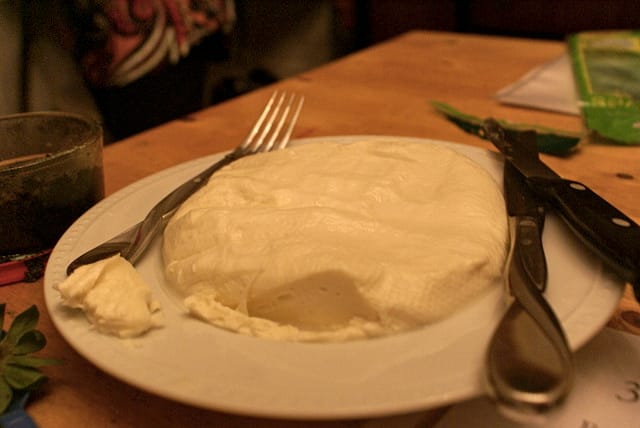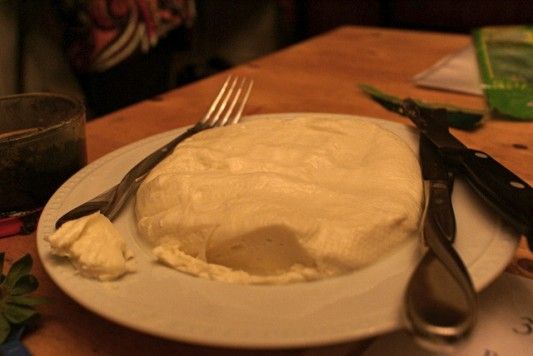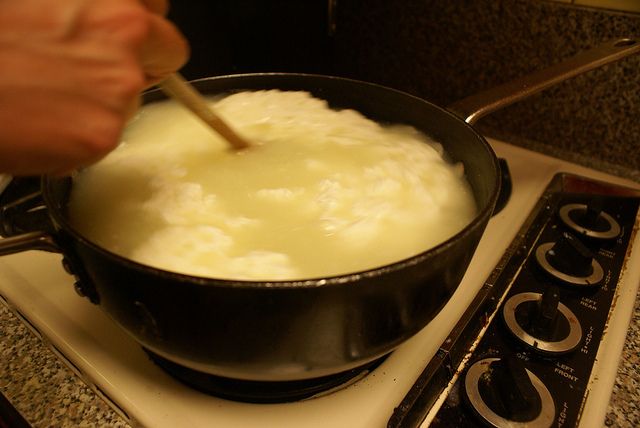Make Your Own Mozzarella


Did you know if you use a gallon of whole milk to make cheese, like magic, you’ll end up with basically a gallon of whey and a pound of mozzarella? It’s not magic, of course, it’s basic chemistry. Once measurements are consistent, it all makes sense.
This isn’t a food blog, it’s a neighborhood blog. So why discuss the chemical transformations of milk proteins? In a few weeks, CSAs will be sending overflowing boxes of summer spoils home with their subscribers. The Greenmarket will explode with possibilities far beyond bok choy. Farmers know more than how to reap and sow. Ask your favorite farmer, “What can I make with [insert interesting item here]?” The worst that can happen is the farmer will roll her eyes and assume you’re a hipster raising bees in your backyard. The best: a quick lesson in making mozzarella.
I was chatting with a farmer at a Greenmarket recently when I mentioned I wanted to learn the mystery behind making mozzarella.
“Oh, that is easy!” he said. “It only takes about 30 minutes.” He delivered a brief history lesson on milk and cheese–did you know the first cheeses were probably made from milk sloshing around in the sheepskin bladder canteens carried by shepherds?–then offered me a recipe.
Back to the chemistry lesson. According to my chemist friend and the Law of Thermodynamics, “You only use 1/10th of the mass of the milk to make mozzarella…so after you remove the fat you’re left with 9/10ths of the initial product, which is whey.” In other words, the volume of the milk fat increases with the cheese production, though the mass does not–cannot. When the milk fat is extracted and expanded, relatively the same amount of liquid as you started with remains. Fascinating.

What do you do with the whey? I use whey in place of water when cooking rice or add it to soup for complex flavor and texture.
A walk through the Cortelyou Greenmarket hints at what else there is to learn. Is it true steaming clams is as easy as sautéing onions and garlic then dumping in the clams and white wine? Ask Seatuck Fish. I sautéed scallops for the first time thanks to their helpful hints. Would Bread Alone reveal the secret to a crispy baguette used to soak up the clam sauce? The only way to find out is to start a conversation.
Don’t worry, friendly purveyors, I’m not cooking farm-to-table every day…or even every weekend. I want to know how to make mozzarella for the same reason I want to know how to change the oil in my car: just because. I own a yogurt maker, but this Sunday I’ll once again stop by Hammond Dairy to pick up vanilla and raspberry yogurts for the week. The quality of Greenmarket products is tops, so I don’t need to make everything from scratch.
30-Minute Mozzarella
Before you start:
Rubber Gloves
Slotted Spoon
Salt
Bowl with Ice Water
1 1/2 teaspoon citric acid dissolved in 1/4 cup water
1/4 teaspoon rennet diluted in 1/4 cup of water
1. Gently warm 1 gallon of milk on stove. Add citric acid solution at 55 degrees. Mix steadily.
2. At 88 degrees, add rennet solution, continue stirring gently until 100 degrees. Put curds into a bowl and squeeze out as much whey as possible. Heat whey up to 175 degrees.
3. Return curds to whey as often as needed to make it stretchy. Add salt. (Use rubber gloves.)
4. Place into ice water filled bowl to cool or roll into small balls and place into ice water.



